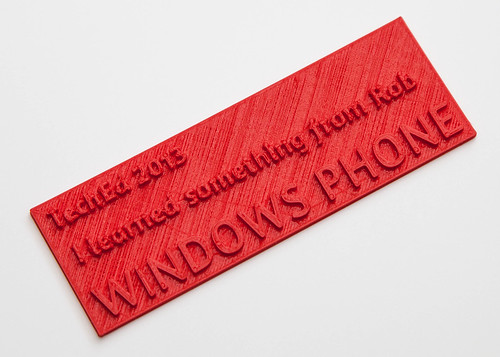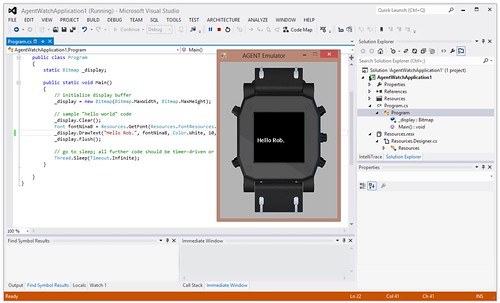Achievement Unlocked: Resits Written
 Tuesday, June 25, 2013 at 09:00PM
Tuesday, June 25, 2013 at 09:00PM  Rob |
Rob |  Post a Comment |
Post a Comment |  Life
Life I've had to give up that Distance Learning course as I was having trouble seeing the teacher.
 Monday, June 24, 2013 at 08:40PM
Monday, June 24, 2013 at 08:40PM I’m always on the lookout for a neat gadget. And at the Gadget Show I found one. What you can see above are Cubelets from ModRobotics. The picture above shows a robot made of little, cooperating cubelets. Each is around an inch on each side, and each is fitted with a set of tiny magnets that allows cubelets to snap to each other and send data back and forth. And each cubelet does something. Above, from left to right you can see a battery cubelet, a distance cubelet and a light cubelet. Black cubelets are sense cubelets, transparent cubes perform some form of action. Coloured cubelets are “thinking” cubelets that do something with the data coming in.
A sense cubelet will send out out the value it “sees” to all the cubelets around it. The distance one sends a signal that gets stronger the closer it is to something. So above you can see the reaction to my camera.
This is a slightly more complicated device. The dark brown cubelet is a “think” one that outputs the larger of the two inputs that are going into it. The red cubelet is an “inverse” one that reverse the sense of the input. So, if something is close to my robot, or the knob is turned to the maximum, the light will grow dimmer.
This one is a bit simpler. The cubelets at each end are drive cubelets. They have little motorised rollers. This robot will run away if I bring my hand too close to the top.
“Programming” with cubelets isn’t really programming at all. They click together and organise themselves so neatly that you just pop them into arrangements to see what they do. They are toy certified for kids from 4 years old, and I reckon that is a place they will really shine. After a bit of fun and games you can get some very complicated behaviours, and start making robots that behave in a way that you want, for example things like line following.
This is my cubelet collection. I’ve no idea what it does, but it definitely does something…
And finally, as if this wasn’t enough, you can actually re-program the thinking cubes in C. The blue cube at the top left hand corner of my collection above is a Bluetooth cube that can talk to your PC.
This is the programming environment that you run inside a browser. It talks to Bluetooth cubelet and allows you to select cubelets in the network and reprogram them.
The whole thing is utterly charming. The programming in C aspect is a bit of a work in progress at the moment, although it does work and ModRobotics are very responsive if you have problems. The system is powered by tiny rechargeable lithium-ion cells in the battery cubelet that seem to last a long time and the cubelets themselves are beautifully made and look like they would stand up to a lot of hammer. The kits are not cheap, but they aren’t bonkers expensive either, and you can always get them “on instalments” by just purchasing a few at a time. Well worth a look if you have any interest in engaging children with computing.
 Rob
Rob
The only place I've found in the UK where you can buy them is RoboSavvy:
http://robosavvy.com/store/product_info.php/products_id/3082
However, they are happy to ship worldwide, if you are happy to pay the gouging customs duty and VAT on the parcel....
 Sunday, June 23, 2013 at 09:08PM
Sunday, June 23, 2013 at 09:08PM I’m doing some sessions at TechEd 2013. If you want to know how to make your Windows Phone use background agents to add value to your application, or respond to what you say, then I’m your man. I’m speaking at 10:00 am on Thursday about speech and 3:15 about background agents. And I’m going to be around at Ask the Experts too.
I had this brilliant plan for TechED US, where I’d give away 3D printed phone cases at my session. I even printed them and everything. Then I found out that the phone that I’d printed the cases for is not actually sold in the US. Which makes me an idiot.
So, instead, this time I’m giving away “I learned something from Rob” ceremonial plaques. These are completely unique, except in the sense that there are more than one of them in existence. I’ll also be giving away lovely 3D printed red rockets. So come along to my session, answer a question and you might be in the running to win.
Above you can see the 3D design for the plaque.

This is what the real thing looks like. With a bit of luck I might see you in Madrid, and give you one.
 Saturday, June 22, 2013 at 09:47PM
Saturday, June 22, 2013 at 09:47PM Peter is still working on his 3D printer. Today I had a go at printing another part for him. It did not end well. As you can see above, when the printer runs out of fibre to print, bad things happen.
I’ve mostly reached the point where failed prints are not as interesting as they used to be, but even so I’m tempted to hang on to this one. The problem came because I’m coming to the end of my lovely pink/magenta fibre and the last few metres are tightly wound around the inside of the spool. When they are fed into the printer the tight curves of the fibre cause more friction in the tube that pushes them into the print head. This gets harder to push, so the knurled bolt that is doing the pushing starts to slip against the fibre, eventually wearing it in two.
Then you get to strip down the feeder and extract the broken bit. Fortunately the print head wasn’t blocked, and so I was able to switch to red fibre (that little coil that looks like red hose is me forcing out the pink and sending in the red) and print all the bits with no problems.
I’m going to have to make something that straightens the pink fibre out so that I can use it.
 Ultimaker
Ultimaker  Friday, June 21, 2013 at 07:24PM
Friday, June 21, 2013 at 07:24PM 
Well, the Kickstarter for the Secret Agent watch has now ended. They’ve finished up with over a million in backing. Good for them. I got my order in early, so in December I might realise another of my dreams, and have a watch I can actually program in C# and make talk to my phone.
I got quite close five years ago, when I got hold of a Microsoft Spot watch. That ran the .NET Microframework and could run C# programs, just not ones that I could write.
The Secret Agent Watch is different. The team have already released an SDK which you can download for free from their web site. This comes with an emulator so that we can begin making our programs now. With a Bluetooth link to a Windows Phone, the possibilities are very exciting.
Note: If you do download the SDK and install it you might find that the first time you try to create a new project in Visual Studio 2012 it hangs. I found that stopping Visual Studio, restarting it, opening an existing project and then making a new one sorted things out.
Now I’m really looking forward to December.